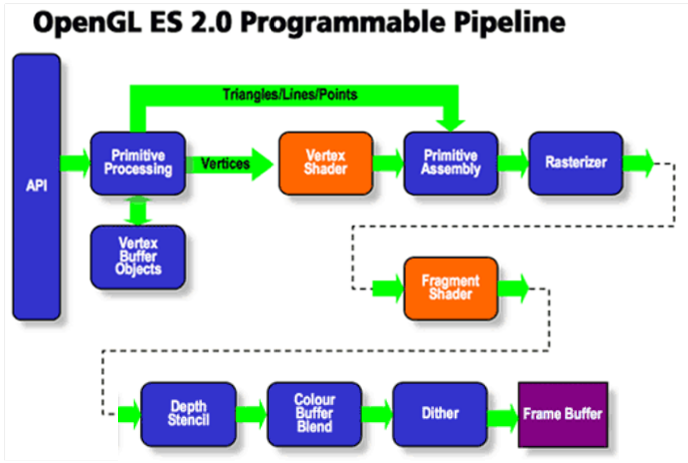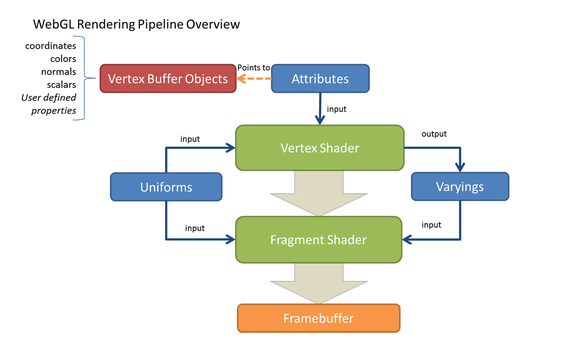Introduction to OpenGL/WebGL
- This is the industry standard 2D graphics package
- Cross language
- Cross platform
- Cross hardware
- It is designed to work with specialized graphics hardware (GPU) to achieve hardware accelerated rendering.
- It is a graphics API or Application Programming Interface.
- There are two basic epochs
- Pre 2.0 - CPU intensive rendering
- you will find this code out there, it is a dead end.
- 2.0 and beyond - GPU based rendering
- Generally includes programs to be run on the GPU
- Before 2.0 nearly everything was done in immediate mode
- Like the HTML5 canvas, client calls directly generate the graphics commands to draw an object
- A series of lines, strokes, ...
- This is heavily dependent on the CPU to do the drawing.
- It has a heavy network cost in transferring data from CPU to GPU
- WebGL
- A javascript API
- A lightweight version of OpenGL
- Supports most of OpenGL
- GLSL
- OpenGL Shading Language
- This is a c like language for implementing programs to run on a gpu.
- This is supported by OpenGL, OpenGL ES, and WebGL
- But slight differences across the languages
- A newer standard Vulkan is an attempt to modernize and unify all of the *GL family.
- Watch, if you do graphics, things will change again.
- WebGPU will replace WebGL
- Retained Mode is the alternative
- The CPU generates a list of objects to be drawn and transfers them to the GPU
- It then asks the GPU to render these objects.
- The CPU will generate updates to the objects, but does not need to re-transmit the data to the GPU, only the updates.
- Arbitrary graphics pipeline
-

- Data (primitives) are generated by the Application
- Along with updates to the environment (transformations)
- And to the objects (changes in data and attributes)
- Geometric transformation are applied to the data
- This includes translate, rotate, ...
- Colors can be computed and applied (but probably not in complex applications)
- But also projection from 3d to 2d
- Items are clipped
- Hidden surfaces might be removed here.
- And points are converted to device coordinates
- In general :
- Multiple modeling coordinates (model coordinates)
- world coordinates
- Viewing coordinates
- Normalized Device Coordinates
- Device coordinates
- At device coordinates, a new set of 2d primitives are processed
- Rasterization
- The process of taking low level 2d primitives and converting them to pixels.
- Color is usually applied here.
- Triangles are converted to lines.
- Lines are converted to pixels.
- A version of hidden surface removal can be done here as well.
- The OpenGL graphics pipeline
-

- Vertex Specification
- Primitives are specified in the program running on the CPU and sent to the GPU as a buffer object
- This is a location in memory on the GPU that contains the data.
- We provide a template for how to interpret this memory.
- This is typically done Once at the beginning of processing, but perhaps other times as well.
- Attributes are set at this time as well.
- Vertex Shader
- This is a programmable stage of the pipeline that runs on the GPU
- Geometric transformations
- Responsible for changing 3d coordinates into 2D coordinates.
- But the projection (ie division by 1/p (x, y, z, p) is not done.
- A program in GLSL that operates on a single vertex.
- But is called MANY times (once per vertex)
- It runs in isolation (no knowledge of other vertexes)
- Can produce other data to send through the pipeline
- Tessellation
- A programmable stage of the pipeline that runs on the GPU after the vertex shader.
- This can break primitives into smaller primitives
- This is not supported in WebGL so we will not discuss this in detail.
- Geometry Shader
- A GPU stage, programmable
- Takes a primitive and outputs one or more primitives.
- Remove ore tessellate primitives further.
- This is not supported in WebGL so we will not discuss this in detail.
- Vertex Post-Processing
- Non-programmable stage
- Clipping occurs here.
- Returning to Homogeneous coordinates (ie perspective divide) takes place here.
- Transformation to viewport (output window) occurs here as well.
- Primitive Assembly
- Non-programmable.
- Vertexes are once again turned into primitives
- Face culling occurs here.
- Rasterization
- Non-programmable
- Primitives are turned into fragments
- Fragments are the pixels more or less.
- Fragment Shader
- Programmable GPU stage
- Are the fragments visible
- Computation of color on a per-fragment basis
- Each fragment is input.
- The color of the fragment and depth is output
- Or discard is called.
- Per-Sample Operations
- Fixed GPU stage
- Depth test
- WebGL has a simpler pipeline
-

- But this might more useful
-




